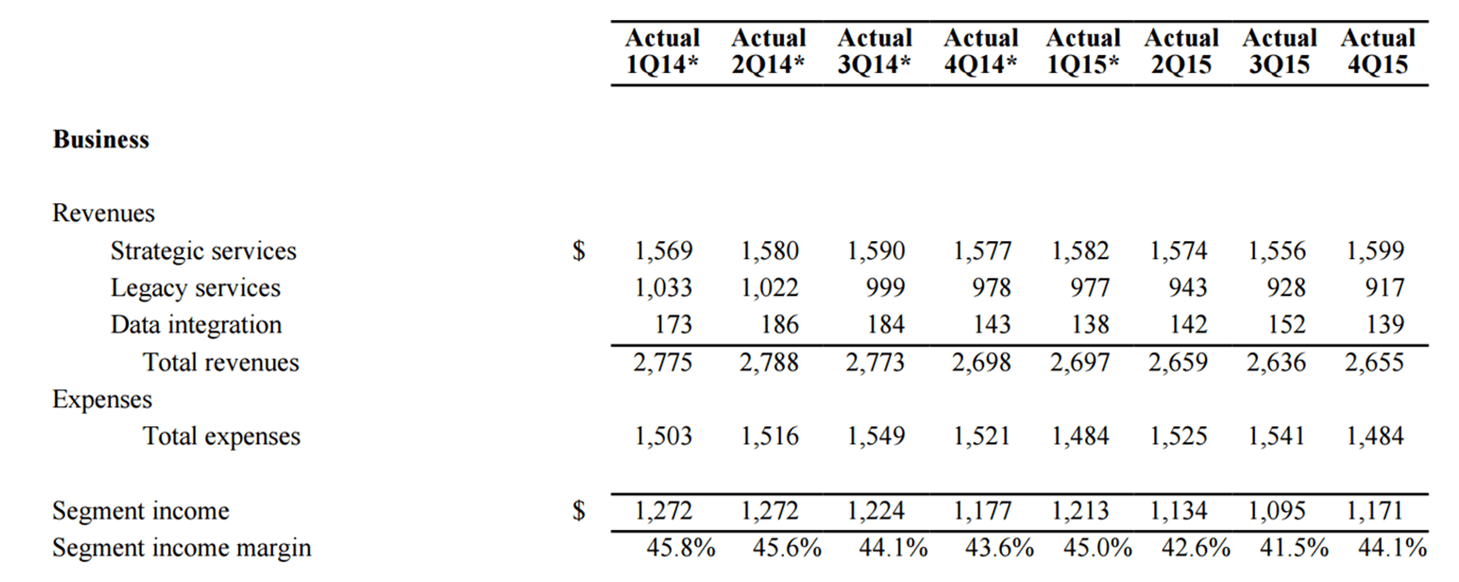Jim Patterson lays out a CenturyLink ‘to do’ list focused on improving broadband speeds and customer experience
Quarterly and full-year earnings continue to trickle in, and this week we will focus on CenturyLink’s metrics and provide some updates on previous “to do” list columns.
CenturyLink’s ‘to do’ list
1. Complete the restructuring/sale of the data center assets. Translate potential interest into acceptable terms.
2. Continue consumer sales momentum (Prism TV, high-speed data).
3. Improve high-speed data churn levels in both consumer and business.
4. Improve sales productivity (achieve the objectives of the 2014/2015 sales reorganization).
5. Expand distribution partnerships, particularly for business products.
6. Demonstrate customer experience effects of streamlined business processes.
7. Refinance $1.2 billion in debt due in 2016 at favorable rates.
8. Integrate new management (Dean Douglas and Bill Hurley).
9. Turn Connect America Fund commitments into a regional competitive advantage.
10. Demonstrate earnings before interest, taxes, depreciation and amortization stability that translates into 3.0x leverage and consistent dividend payouts.
CenturyLink’s earnings call last week was full of candor, confession and confidence (see full earnings release details here). They touted the rollout of their gigabit-capable passive optical network across more than 940,000 addressable households and 490,000 business locations, yet confessed that slightly less than 70% of their footprint is not equipped to compete against the next generation of cable speeds (40 megabits per second and higher).
To CenturyLink’s credit, however, they are offering standalone 40 Mbps service for $30 per month with a one-year commitment (with phone service, the price jumps to $55). That’s more aggressive than they have been in the past, and indicates they are willing to attractively price their product on shorter terms to get a shot against cable.
Nearby is the ACSI table comparing customer satisfaction for Internet service providers. CenturyLink is the lowest scoring incumbent telco in the mix and only a few notches above their principal competitor, Comcast. They score worse on DSLreports.com “Good, Bad and Ugly” index (see here), ranking slightly behind Suddenlink and ahead of Mediacom for overall satisfaction. And the most recent JD Power surveys put CenturyLink at the middle of the pack for both Internet and phone service, better than Comcast (Qwest service territory), but behind Bright House (Florida) and Cox (Las Vegas, Phoenix).

CenturyLink acknowledged their myriad of systems and processes was preventing them from achieving higher levels of satisfaction. CenturyLink CEO Glenn Post, set high expectations when he said, “We … expect to gain revenue and operating efficiencies and improved cash from operations through more aggressive systems consolidation, automation, and process improvement.” Improving delivery intervals, ticket resolution timeframes and self-service metrics will not be easy to accomplish. However, when you are the challenger and not the incumbent for the most valued in-home product (high-speed Internet), you have to differentiate on the customer experience. Dish and DirecTV did it and both grabbed market share as a result.
Once those streamlined processes are in place (and Prism has been rolled out to more locations), CenturyLink should mimic their wireless service brethren and do the unthinkable: offer to pay early termination fees (up to $200) to the customer if they will switch to CenturyLink (GPON) Prism Internet. This would move the needle on revenue growth and give them an opportunity to (re)establish relationships.
It’s likely going to take more capital in 2016 than the $1.2 billion CenturyLink outlined on their call for broadband deployment and capacity if they are going to effectively challenge cable. They outlined on the call that penetration in the GPON markets had already reached 15%, but they have not disclosed how many of those customers were upgrades from DSL and how many were cable conversions. To get the next 15% penetration, it’s going to require a disproportionate level of cable conversion, and performance expectations need to be consistently exceeded.
Finally, CenturyLink’s core business operation (excluding wholesale and hosting) needs to be more profitable. Here’s the supplemental information for business performance by quarter:

While this shows sequential and year-over-year improvement, it’s important to remember these figures now include the wholesale segment, which has historically posted 65% to 70% segment income margins (see this link for the last earnings supplement that had Business, Wholesale and Hosting revenues delineated. A little over a year ago, the segment income margin for business was 36.5% and had dropped 310 basis points year-over-year). It’s likely the returns on the hosting business began to improve in the fourth quarter as CenturyLink took necessary cost measures to improve their EBITDA, and this is probably a key source of the sequential boost.
The retail business division is broken and needs a makeover. More speed, integrated cloud services and superior support could revive their prospects. If CenturyLink does not change, a unified cable industry (Comcast + Charter/TWC/BrightHouse + Cox) will eat their lunch.
’To do’ list updates
Over the past three weeks, there have been a few updates to carriers’ “to do” lists:
1. Verizon made a critical decision to zero rate all data for Verizon Wireless customers who use Go90, their recently launched online service (news release here). Verizon was quick to distinguish its actions from T-Mobile US’ Binge On product, saying they offer the service with no throttling. AT&T is contemplating moving forward with a zero-rated service for their wireless customers and DirecTV. If the Federal Communications Commission does not intervene, Verizon could user this move to attract YouTube content to Go90.
2. Sprint decided to extend their “half off” promotion through the end of March (see press release here). We talked about the need for sustainable replacement to this promotion and it looks like that isn’t ready. Sprint cannot rely on a low margin solution to attract customers. To add to the pain, Sprint also announced a new four-line unlimited plan bundle for $150 (see nearby chart comparison). This new plan will likely drive existing Sprint unlimited plan subscribers to this new rate structure after their current plans expire.

3. New York City does not parlez-vous Français (see Multichannel News article here). New York City Public Advocate Letita James filed a brief with the state PUC on Feb. 5, citing great concerns about Altice’s ability to meet cost cutting commitments to investors without damaging customer service and provisioning. In this CNBC interview Maya Wiley, counsel to Mayor Bill de Blasio, is challenged by David Faber on the city’s ability to hold up a deal. Her response (paraphrased): “We may not have the ultimate approval, and the state PUC might see things differently, but we control your franchise.” Meanwhile, Altice’s stock is about 40% lower than it was one year ago, and more than 65% lower than its peak in mid-June of last year.
4. Charter gets an accelerated date with the California PUC (see Bloomberg Business article here). In a coup of sorts, Charter persuaded the administrative law judge in California to forego a hearing next week and to reach a final decision on the merger by May 12. It is likely California will be the last remaining state to approve the merger (New Jersey and Hawaii approvals are also outstanding). More details are provided in the aforementioned article.
5. Old smartphones are still good enough for some. Parks Associates released their new report on the relationship between home broadband users and smartphones. While many of the study’s findings are not too surprising (e.g., 86% of wired broadband homes have smartphones), it was interesting to find that 33% of all Apple and 30% of all Samsung users in the study owned a device that was over two years old (which would equate to an iPhone 4s, 5c or 5s for Apple and a Galaxy SII, S3, S4 or S5 for Samsung). As we have discussed in many columns, the continuation of subsidy-based plans for iPhones and Galaxy devices encouraged many users to purchase low cost/free models along with a two-year contract commitment. Sprint continued to give away these units with two-year contracts well into 2015, even though this particular model did not have an LTE ratio (it was CDMA2000 1x EV-DO Revision A only). If the Parks Associates research is any indication, they may be living with this decision for a while.
6. India flexes net neutrality muscle (and draws anti-colonialism tweet from one of their board members). In one of those “wish you hadn’t said that” moments, Facebook board member Marc Andreesen took to Twitter to lash out at the Indian government’s decision to ban Facebook’s Free Basics offering (his since deleted tweet is posted nearby). Andressen later apologized for his “ill-advised and ill-informed” comments. Facebook founder Mark Zuckerberg also publicly chastised his board member (but, interestingly, did not ask him to step down). Bet that next board meeting will be an exciting one.

7. Can’t let this week go without a final reference to the T-Mobile US Super Bowl ads here and here. Steve Harvey correcting the record – genius.
Next week, we’ll focus on commentary from T-Mobile US’ profits (Wednesday), provide a preview of Mobile World Congress and comment on Samsung’s Unpacked 2016 event.

Jim Patterson is CEO of Patterson Advisory Group, a tactical consulting and advisory services firm dedicated to the telecommunications industry. Previously, he was EVP – business development for Infotel Broadband Services Ltd., the 4G service provider for Reliance Industries Ltd. Patterson also co-founded Mobile Symmetry, an identity-focused applications platform for wireless broadband carriers that was acquired by Infotel in 2011. Prior to Mobile Symmetry, Patterson was president – wholesale services for Sprint and has a career that spans over 20 years in telecom and technology. Patterson welcomes your comments at jim@pattersonadvice.com and you can follow him on Twitter @pattersonadvice. Also, check out more columns and insight from Jim Patterson at mysundaybrief.com.
Editor’s Note: The RCR Wireless News Reality Check section is where C-level executives and advisory firms from across the mobile industry share unique insights and experiences.

